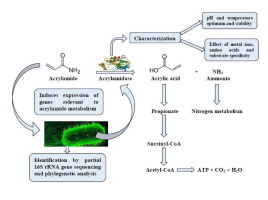Biodegradation of acrylamide by a novel isolate, Cupriavidus oxalaticus ICTDB921: identification, and characterization of the acrylamidase produced
Dattatray K. Bedade, Rekha S. Singhal
Index: 10.1016/j.biortech.2018.04.012
Full Text: HTML
Abstract

Acrylamide is neurotoxic, genotoxic, teratogenic and carcinogenic. Its widespread use in various industrial processes leads to environmental contamination. Acrylamidase produced by certain bacteria degrade acrylamide to acrylic acid and ammonia. The present study details the isolation and identification of soil bacterium which could degrade acrylamide. Among the 18 acrylamide-degrading isolates tested, isolate ICTDB921 demonstrated superior acrylamide degradation which was analyzed by HPLC and FTIR. The partial 16S rRNA sequencing confirmed the isolate to be Cupriavidus oxalaticus ICTDB921, which showed highest growth at 60mM acrylamide, neutral pH and 30°C. The kinetic model predictions are consistent with experimental results. The acrylamidase from this isolate showed potency at pH (6-8) and temperatures (30-60°C), with reasonable pH (6-8) and thermal stability (upto 60°C). The enzyme was stable against most metal ions and amino acids, and also degraded other aliphatic amides, demonstrating its potential in remediation of acrylamide from the environment and food systems.
|
Sustainable green pretreatment approach to biomass-to-energy...
2018-04-12 [10.1016/j.biortech.2018.04.039] |
|
Adsorption removal of natural organic matters in waters usin...
2018-04-07 [10.1016/j.biortech.2018.04.016] |
|
Combined bioaugmentation with anaerobic ruminal fungi and fe...
2018-04-03 [10.1016/j.biortech.2018.03.128] |
|
Biocatalytic strategies for the production of high fructose ...
2018-04-03 [10.1016/j.biortech.2018.03.127] |
|
High-frequency, high-intensity electromagnetic field effects...
2018-04-03 [10.1016/j.biortech.2018.03.130] |